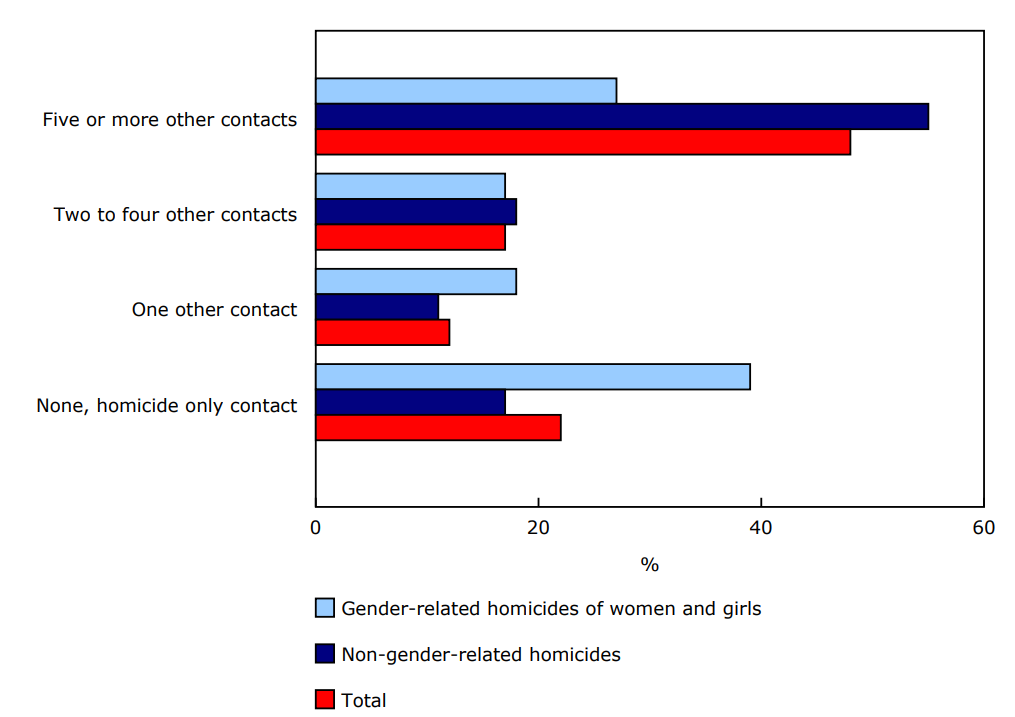
From 2009 to 2022, most (68%) solved homicides of women and girls in Canada were gender-related. Gender-related homicides of women and girls are those committed by a man or boy who was an intimate partner or family member of the victim, or who inflicted sexual violence on the victim as part of the homicide, or who killed a woman or girl who was identified by police as a sex worker.
The Juristat article release today, entitled "Police contacts and sociodemographic characteristics of persons accused of gender-related homicide in Canada, 2009 to 2022," examines offending patterns and characteristics of accused persons. This comprehensive analysis, carried out for the first time in Canada, was made possible by the integration of multiple data sources.
Men and boys accused of a gender-related homicide have fewer contacts with police
From 2009 to 2022, 1,328 men and boys were accused of a gender-related homicide in Canada, and fewer of these accused persons had another contact with police than persons accused of a non-gender-related homicide. Specifically, about 6 in 10 (61%) men and boys accused of gender-related homicide had at least one other contact with police, either before or after the homicide, compared with about 8 in 10 (83%) persons accused of a non-gender-related homicide.
Chart 1: Number of police contacts among persons accused of homicide, by gender-related status, Canada, 2009 to 2022

Description - Chart 1
Data table: Number of police contacts among persons accused of homicide, by gender-related status, Canada, 2009 to 2022
Notes: Based on unique individuals accused of a gender-related or non-gender-related homicide who were successfully linked to accused record data in the Uniform Crime Reporting Survey. Gender-related homicides of women and girls are solved homicides committed by a man or boy accused who was an intimate partner or family member of the victim, inflicted sexual violence on the victim as part of the killing or killed a victim who was identified as a sex worker. Non-gender-related homicides are all those that do not contain the above qualifiers but have a known accused. If one accused was involved in multiple homicides during the reference period, the gender-related homicide is counted. There may be a small number of homicides included in a given year's total that occurred in previous years. Homicides are counted according to the year in which they are reported to Statistics Canada. Excludes victims and accused where gender was coded as unknown.
Sources: Gender-related homicide record linkage file (3315).
Among men and boys accused of a gender-related homicide who had at least one other contact with police during the reference period, the largest proportion (43%) had five or more additional contacts, while about 3 in 10 (29%) had just one other contact—a larger proportion than among persons accused of a non-gender-related homicide (13%).
Nearly one-third of prior police contacts among men and boys accused of gender-related homicide occur in the year before the homicide
From 2009 to 2022, for men and boys accused of a gender-related homicide with at least one prior police contact, more than one in seven (15%) had their most recent contact in the three months before the homicide, and nearly one-third (30%) had a prior contact in the year before the homicide.
In contrast, a greater proportion of persons accused of a non-gender-related homicide had a police contact three months before (25%) or one year before (47%) the homicide.
While fewer men and boys accused of a gender-related homicide had a police contact in the year before the homicide, the last contact more often involved a violent offence as the most serious violation (42%) compared with the last contact among persons accused of a non-gender-related homicide (33%).
Repeat victimization more common in cases of gender-related homicide
For those accused of a gender-related homicide who had other police contacts involving violent crimes from 2009 to 2022, nearly half (44%) involved intimate partner or family violence. Specifically, over one in four (27%) violent crimes were against an intimate partner, while 17% were against another family member (excluding spouses).
Of prior police contacts involving a violent offence, 1 in 10 (10%) were perpetrated against the same woman or girl who was later killed in the gender-related homicide incident. This proportion more than doubles (25%) when the accused shared an intimate partner or family relationship with the victim.
In comparison, 0.8% of violent offences were perpetrated against the same person who was later killed in the non-gender-related homicide incident.
Key sociodemographic differences exist between accused persons by the type of homicide committed
Men and boys accused of a gender-related homicide from 2009 to 2022 were older, were more often enrolled in higher levels of education and were less frequently in a low-income situation compared with persons accused of a non-gender-related homicide.
Also, fewer men and boys accused of a gender-related homicide had consumed drugs or alcohol at the time of the offence, and they had less extensive reported criminal histories. In contrast, they were more often admitted to an emergency department at least once in the year prior to the homicide, and a greater proportion died by suicide relative to those accused of a non-gender-related homicide.
Note to readers
Details about the educational background, immigrant status, health care contacts and reported income among those accused of gender-related and non-gender-related homicide are available in the Juristat article.
To examine prior and subsequent police contact among persons accused of a homicide, data from the Homicide Survey were linked with data from the Uniform Crime Reporting (UCR) Survey, where all homicide incidents reported by police from 2009 to 2022 were selected for the cohort. The inclusion criteria required at least one identified accused person and charges being either laid or recommended by police, or the homicide incident being cleared otherwise.
While this analysis focuses on gender-related homicides of women and girls, all cleared (i.e., solved) homicide incidents were included in the linkage to allow for comparisons with non-gender-related homicides. The classification of gender-related homicides requires the accused to be a man or boy. Non-gender-related homicides can be perpetrated by an accused person of any gender so long as the case does not contain evidence of the required gender-related criteria.
Of the gender-related homicides, 98% were successfully linked to the primary accused record in the UCR Survey. The linkage rate was comparable to that of non-gender-related homicides (97%) over the same period. In total, there were 5,967 unique persons accused of committing a homicide in the linked data file: 1,328 men and boys accused of a gender-related homicide and 4,639 persons accused of a non-gender-related homicide.
A police contact is defined as another contact with police for any criminal offence (either before or after the homicide occurred) where charges were either laid or recommended by police, or the incident was cleared otherwise. The linkage data reflect only homicides and other crimes that were reported by police from January 1, 2009, to December 31, 2022. Therefore, any crimes that were reported outside this period are not in scope.
The Homicide Survey has collected police-reported information on the characteristics of homicide incidents, victims and accused persons in Canada since 1961. Detailed information about the Homicide Survey can be found on Statistics Canada's website.
The Incident-based UCR Survey is a microdata survey that captures detailed information on the characteristics of victims, accused persons and incidents. Detailed information about the UCR Survey can be found on Statistics Canada's website.
Since 2019, the Homicide Survey has collected information on the gender identity of victims and persons accused of homicide. Gender refers to the gender a person publicly expresses in their daily life, including at work, while shopping or accessing other services, in their housing environment, or in the broader community. The option to code victims and accused persons as "non-binary" in the UCR Survey was implemented in 2018.
In the context of the UCR Survey, a non-binary person refers to a person who publicly expresses as neither exclusively male nor exclusively female. In both surveys, victims and accused persons who reported or were identified as being non-binary have been distributed to either the men and boys category or the women and girls category based on the regional distribution of victims' or accused persons' gender. This recoding ensures the protection of confidentiality and the privacy of victims and accused persons.
Contact information
------For more information, contact the Statistical Information Service (toll-free 1-800-263-1136; 514-283-8300; infostats@statcan.gc.ca) or Media Relations (statcan.mediahotline-ligneinfomedias.statcan@statcan.gc.ca).